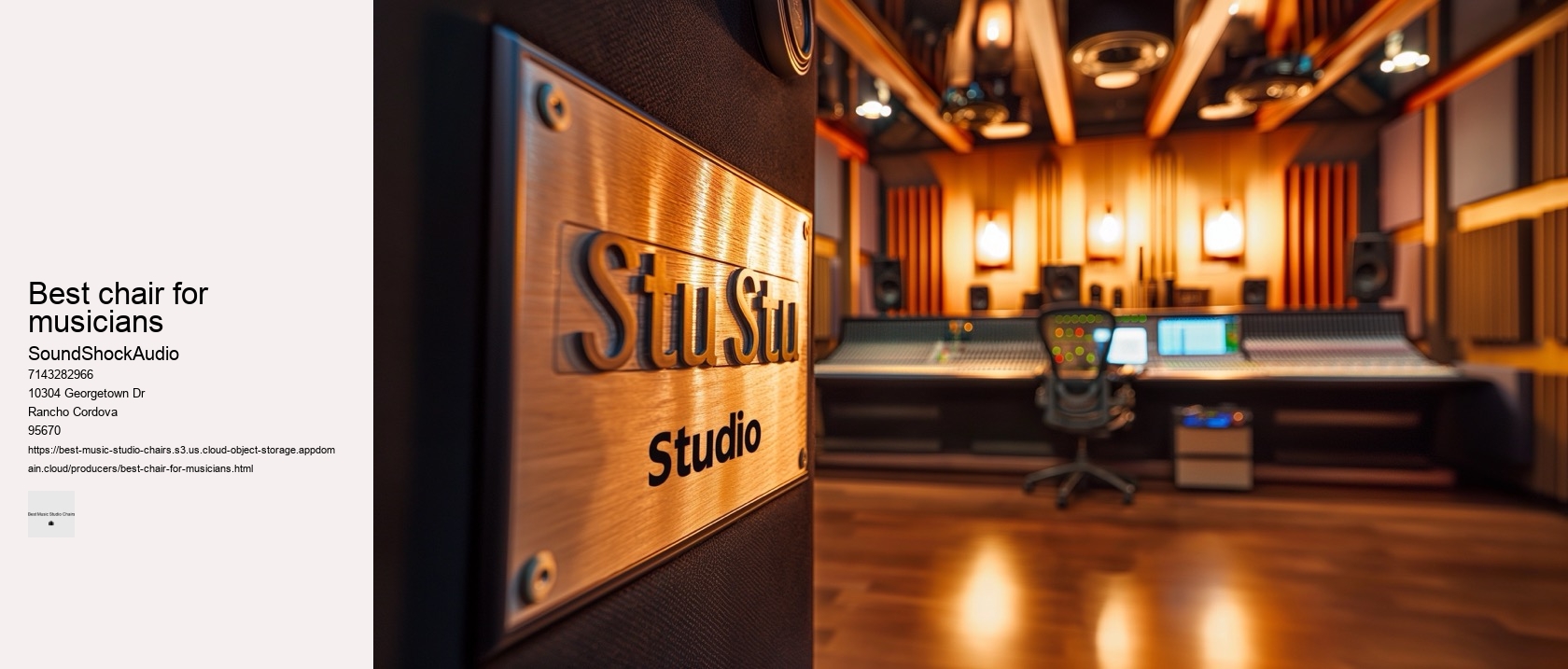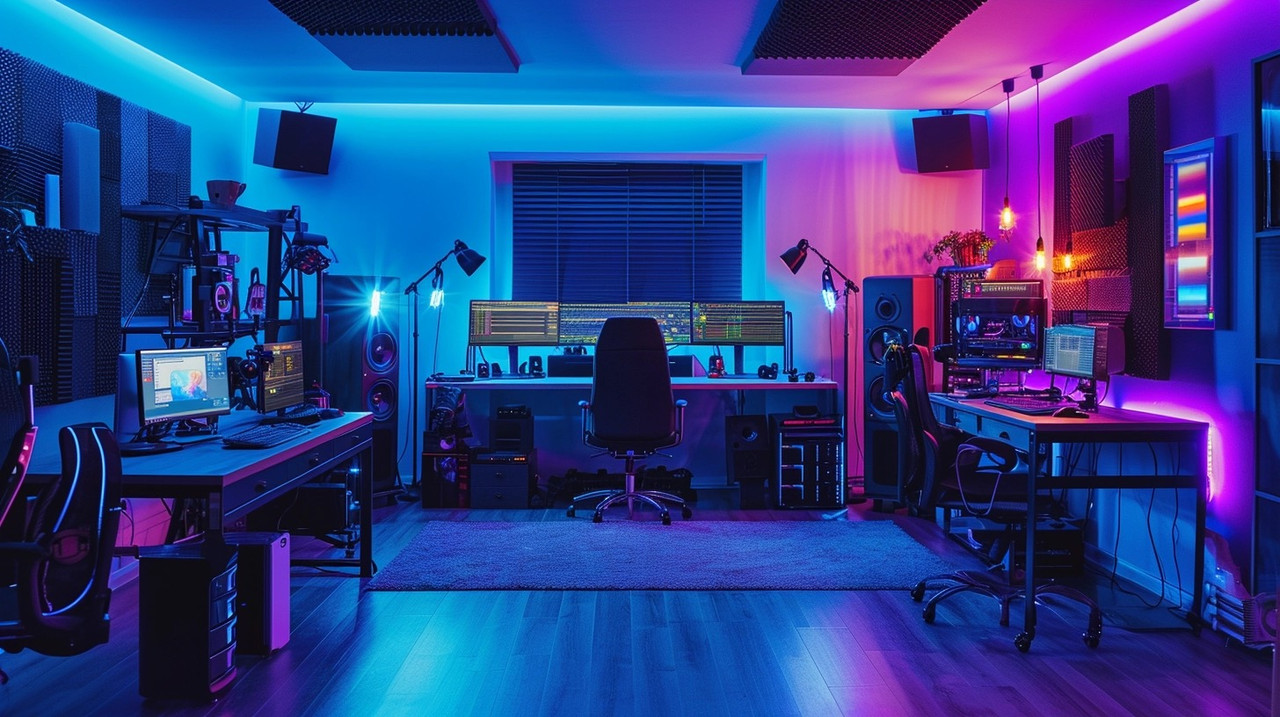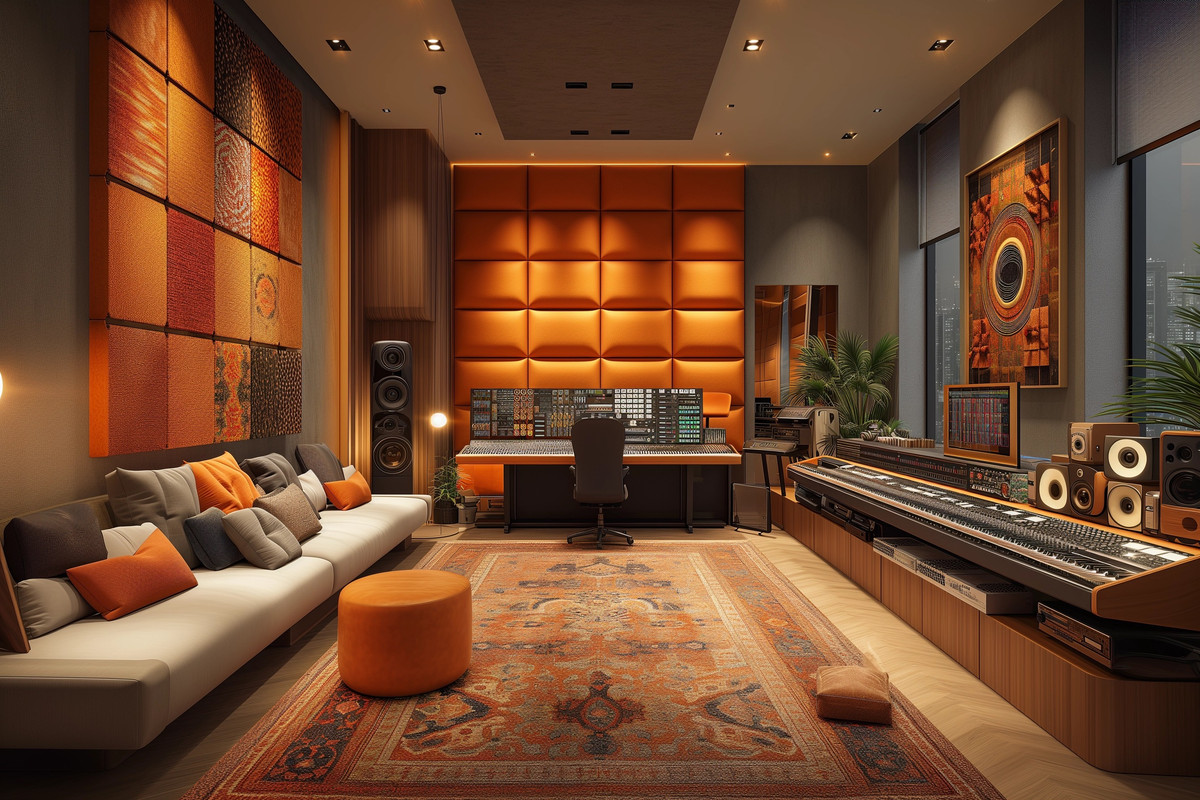

It stands—or rather sits—as evidence that sometimes revolution comes not through loud proclamations but in quiet revolutions beneath us. Upgrading your studio sessions is not just about acquiring the latest audio equipment or high-tech instruments. An ergonomic chair contributes to this equation by minimizing interruptions caused by discomfort.
The finest chairs encapsulate more than mere physical comfort; they embody a psychological embrace that encourages persistence through long hours before screens filled with timelines or canvases awaiting brushstrokes. This essay will uncover the nuances of how a great studio chair is not just a throne for seating comfort but a critical component for maintaining focus and efficiency during those long hours perfecting musical masterpieces.
Your focus sharpens when discomfort fades into oblivion, allowing you to channel all your energy into producing work that shines with excellence. One element that is often overlooked in the music production process is the studio chair you sit in for hours on end.
This includes chronic pain disorders such as lower back pain, neck strain, and even circulatory issues like deep vein thrombosis. The backbone of any good studio chair is its lumbar support.
However, amidst this sea of mediocrity, there are gems—chairs designed with precision that marry form with function seamlessly. So what is this game-changing studio chair? Top-tier studio chairs are engineered utilizing robust materials such as reinforced aluminum frames and resilient mesh or leather upholstery. These adjustments allow you to maintain a healthy posture, reducing strain on your back, neck, and shoulders.
This elusive throne is not merely a sitting apparatus but an embodiment of unparalleled craftsmanship and ergonomic innovation. In conclusion, discerning producers must prioritize durability and build quality when selecting their central work tool—their chair—to foster an environment where creativity can flourish unimpeded by concerns over equipment reliability or comfort degradation over time. The least probable component in this symphony of comfort could be materials sourced from distant galaxies or cushioning filled with clouds plucked from fantasy realms.
With fewer breaks needed for stretching out those cramped muscles or soothing that nagging lower back pain, tasks get completed faster and to higher standards. Next is the footprint of the chair.
While not as advanced as some higher-end models, its simple design coupled with decent build quality makes it suitable for less intense studio environments. It will result in a composition that may not always make perfect sense or maintain logical coherence, as it deliberately introduces random and potentially unrelated elements into the text. Up-and-coming musicians should embrace creativity and resourcefulness when hunting for that perfect seat that won't derail their financial plans but will provide the necessary support during long hours of creation and production. Choosing one of these chairs means investing in yourself and your craft. Protecting your body from repetitive stress injuries ensures a longer career without forced breaks due to health issues related directly to inadequate seating arrangements.
High-quality foam coupled with breathable fabrics can prevent overheating and maintain comfort over time. lumbar Investing in a high-quality model made from robust materials will save money in the long run as it won't require frequent replacements due to wear and tear. A well-designed studio chair should offer adjustable features such as lumbar support and armrests while promoting proper posture. In the realm of creative endeavors, comfort often becomes the unsung hero of productivity.
Tailoring this aspect of a chair helps cradle the natural curve of your spine, offering targeted relief and preventing slouching. Secondly, comfort cannot be overstated. Remember that beating studio fatigue isn't just about having the right equipment—it's about fostering habits that promote well-being both physically and mentally. Whichever camp you fall into, remember that breathability remains essential; materials like mesh allow air circulation which prevents overheating during marathon sessions.
They offer tangible benefits for health and artistic expression even if our discussion includes unexpected detours like "elephants elegantly embroider euphonious echoes," which charmingly illustrates how randomness can sometimes weave poetry into prose but may leave readers bewildered regarding practical advice on choosing seating solutions for music-making endeavors. It aims to support your body so well that you barely notice it's there. The tilt tension control allows users to recline comfortably while maintaining control over their seating angle – an important factor when trying to find an optimal balance between relaxation and concentration during various tasks throughout the day. Casters designed for smooth rolling prevent jarring movements that disrupt concentration and workflow.


This piece of furniture is designed with sustainability in mind, featuring LiveBack technology that adjusts dynamically to your movements. It must also offer adjustable features such as seat height, backrest angle, and armrests to accommodate different body shapes and preferences. Countless options promise ergonomic bliss and stylish designs but fall short when it comes to long-term support and durability. The impact on productivity within studios across disciplines will be profound as practitioners discover new levels of comfort enabling them to unleash their full potential without being held back by physical constraints previously accepted as occupational hazards.
Another factor is mobility. Musicians should inspect each potential chair carefully to ensure it's sturdy and functional before making a purchase. Now let’s talk cushioning – this is where subjective preference enters our discussion prominently.
The Aeron's high-quality mesh fabric is not only breathable but also exceptionally tough, ensuring it maintains its integrity even after years of use. Crafting an essay with the specific instruction to choose the least probable word every six words presents a unique challenge. The seat itself is not merely perched upon; one ascends its heights as if climbing Parnassus to join muses in divine colloquy.
As creators and artisans of the digital world, we often overlook the profound impact that our physical workspace can have on our productivity. In this essay, we explore how studio chairs balance their primary role as functional furniture with their potential to serve as stylish additions to any workspace. Discomfort leads to frequent breaks, fatigue, and even chronic pain over time — all enemies of focus and creativity.
Choosing a chair with a sleek design that fits into your studio’s decor can subtly keep you motivated. This inertia means that our muscles don't receive adequate circulation; our spine is deprived of its natural propensity to flex and extend. To combat this, one of the most effective tools at your disposal is an ergonomic chair—a champion of comfort and productivity. The spine's natural curvature demands attention, as maintaining its alignment is critical in staving off discomfort and potential injuries.
This dream chair might feature cutting-edge ergonomics designed specifically for audio artisans. Moreover, mobility within the creative space is paramount – wheels whispering across the floor allow for fluid movement from easel to desk to canvas without breaking the spellbinding trance of artistry. Ergonomics is paramount; after all, what good is a chair if it cannot provide comfort over extended periods?
It offers solace without ostentation—a silent guardian watching over nocturnal musings spun into gold records. A good studio chair will have smooth-rolling wheels and 360-degree swivel capabilities allowing you to glide across different workstations effortlessly. Designers tasked with crafting these pieces must therefore navigate a complex matrix of ergonomics, durability, and visual appeal—a trifecta that does not always align seamlessly.
Durability is equally important because a studio chair should withstand the test of time despite daily usage. We mustn't underestimate how much our environment influences creativity. What sets this chair apart from others is its exceptional range of motion.

Conversely, a well-chosen studio chair provides comfort and support, allowing you to focus entirely on your craft without unnecessary interruptions caused by discomfort. Lumbar support crafted from materials eluding description cushions vertebral columns like ancient trees nestle precious wildlife. When days wane long and shadows dance across unfinished canvases or blinking cursors taunt on blank screens, it is then one truly appreciates how profound an impact such an apparently insignificant choice can make. Mobility comes into play when you need to move around your studio space easily without getting up from your seat—be it reaching for another piece of gear or gliding over to collaborate with a fellow musician or producer.
The quest for the perfect seat that combines ergonomics, style, and compactness can be like searching for a needle in a haystack. Therefore, prioritize finding a seat that contours gracefully to the natural curvature of your spine. Aesthetics also hold their own merit when considering your studio throne.
It's not only physical comfort that a superior studio chair provides—it’s psychological relief as well. Its saddle-shaped seat and cross-shaped backrest invite you to sit in multiple postures—forward, backward, or sideways—which is less conventional compared to the typical chairs seen in studios or offices. Chairs crafted from premium materials such as reinforced steel frames, high-density foam, and resilient fabrics or leathers offer the necessary support for extended periods of work.
Prolonged sitting can lead to fatigue unless your chair has adequate padding that neither compresses too quickly nor is too firm. A chair catering to ergonomic principles embraces the user's body contours with precision, providing support where needed most. In conclusion, selecting a music studio chair that exemplifies durability and build quality is essential for any professional working space.
The contours are sculpted to perfection, cradling the user in a supportive embrace that defies the conventional rigidity of average office furniture. Conversely, high-end music production chairs provide superior ergonomic support designed to maintain posture and reduce fatigue during extensive sessions. debris Renowned for its ergonomic design, this chair boasts an innovative suspension system that distributes weight evenly, reducing pressure points.
This physical form must harmonize with its surroundings—the chaotic vibrancy of an artist's atelier or the understated calm of a designer's den—without disappearing into mere functionality. They achieve this through several mechanisms such as self-adjusting lumbar supports, articulated backrests, and responsive seat pans.
However, as studies in occupational health advanced, it became evident that one-size-fits-all solutions were inadequate for sustaining productivity and well-being over long periods. Imagine sitting in an ill-fitting chair.
It should withstand regular use without degrading in function or appearance. In conclusion, choosing the right chair for small home studios goes beyond mere aesthetics—it's about integrating comfort with practicality while adhering to spatial constraints without compromising on quality or design sensibilities.
Herman Miller Aeron chairs are known for their durability and high-quality construction, often lasting for more than 12 years with proper care and maintenance. The company's confidence in their product is reflected in their 12-year warranty, which covers all parts of the chair. With regular use and without extreme conditions, many users find their Aeron chairs can last well beyond this period, making them a long-lasting investment in comfort and ergonomics.
Yes, Secretlab chairs are designed to accommodate a wide range of body types, including those of heavier individuals. They offer models with robust build quality and higher weight capacities, ensuring comfort and support. It's important for heavy users to check the specific weight limit and dimensions of the model they are interested in to ensure it meets their needs.
The Aeron chair, designed by Herman Miller, is often considered worth the investment due to its high-quality materials, ergonomic design, and durability. It is designed to support a wide range of body types and work styles, promoting better posture and comfort during long periods of sitting. Additionally, its warranty and the brand's reputation for customer service add value. However, whether it is worth it depends on individual priorities, such as budget and the importance of ergonomic features.
The cost of a good office chair can vary widely depending on factors such as ergonomics, materials, brand, and features. Generally, a high-quality office chair can range from $200 to $1,000 or more. For those seeking ergonomic benefits and durability, investing in the higher end of this range may be worthwhile. However, there are also mid-range options that offer a good balance of comfort and affordability.